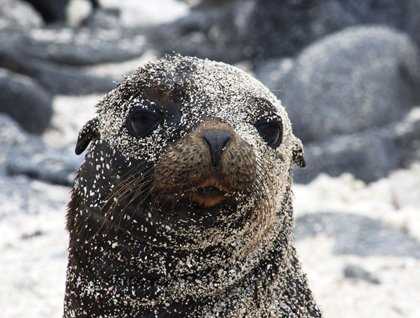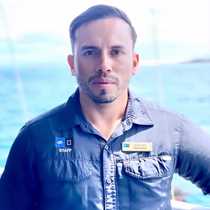Cloud cover gives our early morning a gray tone, with young black basalt lava flows on Santiago Island completing this black and white picture. We anchored just outside of the channel that separates Chinese Hat and Santiago islands and we note the turquoise waters.
A Zodiac ride starts our morning as we look for shorebirds and we come upon Galápagos penguins preening themselves in the sun that is starting to poke through the cloud cover. A small population of penguins resides along this coastal area as cooler currents from the western archipelago bathe this area in temperatures conducive for penguin habitat. It surprised us all to find penguins on lava flows among reptiles here at the equator. A forest of candelabra cactus is surrounded by this recent lava flow on Santiago and we find great blue and lava herons fishing along this coast. Upon our return we prepare ourselves to return to this same site as we concentrate on snorkeling in one of the best sites of the Galápagos. Penguins flit between us as they “fly” by. Large schools of panamic sergeant majors, razor surgeonfish, and creole fish surround us. Some of us land on Chinese Hat for a short walk and find a rugged new lava terrain teeming with life.
As we navigate to our afternoon site we pass by the Bainbridge islands and from the ship we are able to look into a tuff ash formation and its crater. Greater flamingos are spotted claiming as their own a brackish pond on the inside of the crater.
The afternoon allows us a chance to land on a lava flow that is just over 100 years in age. Sullivan Bay is wonderful as it allows us a window into the formation of volcanic islands and also the arrival and establishment of some of the Galápagos’ unique species. Pahoehoe lava flows had been laid down very quickly here during the volcanic eruption and we find folded and twisted basalt under foot as we head inland. Mullugo, a small pioneer plant species, is seen poking out of the numerous cracks and crevices in this flow. These plants allow the break down and eventual erosion of the basalt, eventually creating top soil for the next wave of arrival and establishment of plant species. Galápagos lava lizards seem to be the only representative of animal life on this desolate land. As we return to our floating home we are cooled by a thunderstorm that changes the shadows and reflections of this land and we all marvel at the power and formation of our planet.









